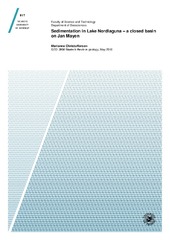Sedimentation in Lake Nordlaguna - a closed basin on Jan Mayen
Permanent link
https://hdl.handle.net/10037/12873Date
2018-05-15Type
Master thesisMastergradsoppgave
Author
Christoffersen, MarianneAbstract
This thesis focuses on the lake Nordlaguna on Jan Mayen. Nordlaguna is closed basin separated from the ocean by a barrier and surrounded by steep mountains and valleys. The lake has the potential to be a paleoclimatic archive and provide information about the unknown sea-level history of the island. When lake sediments are used in paleoclimatic studies, it is useful to acquire knowledge about the modern sedimentary processes of the lake in order to trace changes in the sedimentary record, as well as obtaining a reliable chronology. The overall aim of the thesis is to gain knowledge about the sedimentation in the lake and to evaluate the potential of using two sediment cores from the lake, NL2 and NL1B, to study past environmental conditions. A geological map of the sediment distribution and geomorphology of the study area was produced by combining field investigations of the terrestrial environment with bathymetry and Side Scanning Sonar data from the lake. Field observations, lithological logging, and roundness- and grain-size analyses from the terrestrial environment were used to gain knowledge of the importance of the sedimentary sources. Two sediment cores from the lake were used to connect the modern sedimentary processes with the sediment record.
Five main sedimentary sources were found: temporal and seasonal fluvial activity, deposition by wash-over events on the barrier, mass movement processes from the slopes that extend into the lake, wind-blown sediments, and pyroclastic fallout. The distribution of the sediments are controlled by the proximity to the source as well as processes within the lake, such as the transport of sediments in suspension or underflows, wave- and current-activity, lake-level fluctuations and subaqueous slides.
The dating of core NL2 revealed an irregular pattern that may be a result of deposition of old terrestrial material or redistribution of the sediments. In core NL2, the absence of organic material provided an inadequate chronology. This suggests that the chronology of the cores can be considered unreliable, and may complicate their use in studies of past environmental conditions. Although the chronology is poor, variations in the sedimentary records that may be traced to changes in local environmental conditions were observed. Variations in thickness of laminated silt, that were interpreted as annually deposited varves, can be caused by glacier fluctuations that are recorded from the island, and a significant increase in the amount of wash-over sediments suggests increased coastal erosion due to decreasing sea-ice extent.
Publisher
UiT Norges arktiske universitetUiT The Arctic University of Norway
Metadata
Show full item recordCollections
Copyright 2018 The Author(s)
The following license file are associated with this item:


 English
English norsk
norsk
